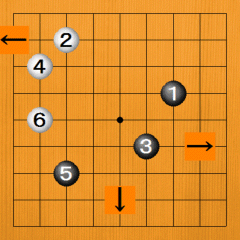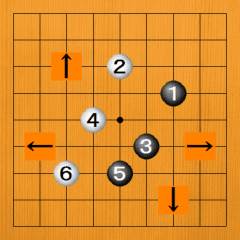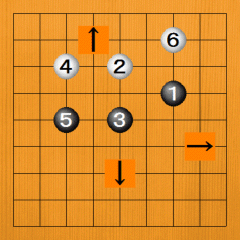 |
[4]How to think about the opening

· The beginning of the game is called the opening. When the number of stones increases and the position gets complicated, it's called the middle game. The last stage is called the endgame.
· Dia. 13. Let's play the opening in a leisurely way. Black 1, 3 and 5 are not too close to each other; they map out a large potential area. However, White 2, 4 and 6 enclose a narrow area. The potential looks small. |
 |

Dia. 13 |
|
· Dia. 14. Black 1 and 3 are the same as before. With 2 and 4, White plays further from the edge. White's territory has greatly expanded. Next, in order to expand his territory, playing conservatively with Black 5 is probably best. White plays grandly with 6 and can match Black's territory. Working out your strategy like this is the enjoyable thing about Go. |
 |

Dia. 14 |
|
· (Application) Dia. 15. In the previous diagram, White thought strategically and built an excellent position, so Black has to try to plan better than him. Black 1 and White 2 are the same. Black 3 is a new plan. If White 4, Black keeps expanding his position with 5. This way, Black's territory looks larger than White's. |
 |

Dia. 15 |
|
· Dia. 16. Well, how about if this time White tries jumping into Black's position with 6? The area that looked like becoming Black's territory might become White's territory. For the continuation, let's look at the next diagram. |
 |
Dia. 16
|
|
· Dia. 17. If next Black checks White's expansion with 1, White builds a territory with 2 to 6, small though it is. An area that was originally Black's position has been emptied out. Getting in the opponent's way like this is an excellent strategy. |
 |
Dia. 17
|
|
· (Actual game example 1) Dia. 18. In this game, both sides play simply with Black 1 and White 2. When Black plays 3, expanding in this direction from White 2 is blocked, so White changes direction to the bottom right with 4. Black expands the bottom left with 5, so White expands to the right with 6. When the stones get scattered in various directions like this, it's hard to grasp what is going on. It's puzzling to know how to continue now. But thinking about these puzzles is what makes Go fun. Agonizing over your moves makes you stronger. |
 |
Dia. 18
|
|
Dia. 19. Next, the game continues up to Black 7, with Black making a large territory on the bottom left. The areas on the right and the top left look like becoming white territory. |
 |
Dia. 19
|
|
· (Actual game example 2) Dia. 20. Black looks like getting a big territory in the bottom right with 1 and 3. Therefore, White plunges in with 4. White is trying to foil Black's strategy by turning the bottom right into White's territory. Black 5 stops White from expanding in this direction. White 6 and 8 secure a small territory. Next, White switches to 10, trying to build a territory in the top left. |
 |
Dia. 20
|
|
· Dia. 21. Next, Black plays 1, blocking White's invasion while building a black territory in the bottom left. White expands his top left territory with 2 to 6. Black matches him by expanding his top right territory with 7 and 9. Please look at the whole board after White 12. Black has territories in the top right and bottom left. White has secured the top left and the bottom right. This is the basic way of playing, with both sides expanding their territories. |
 |
Dia. 21
|
|
 |